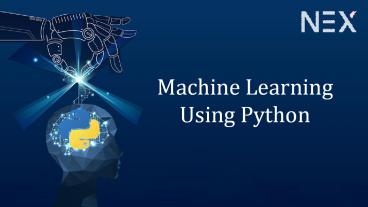How Python can be used for machine learning? - PowerPoint PPT Presentation
Title:
How Python can be used for machine learning?
Description:
I would suggest you can use the python code for machine learning algorithms, in this presentation to easily implement and explore code in your projects. – PowerPoint PPT presentation
Number of Views:3146
Title: How Python can be used for machine learning?
1
Machine Learning Using Python
Machine Learning Using Python
2
Introduction
The best subject of all the Artificial
Intelligence domain is machine learning which has
been in the news for quite some time. This field
has the potential to provide a better and
necessary opportunity. It is very easy to start a
career even if you have zero in Mathematics or
Programming. Even if you have experience, there
is no problem because it is the most important
element for your success, purely to help you
learn those things. Data for which you have your
interest and inspiration.
If you are new then you do not know where to
start studying and why you need machine learning
and why it is gaining the most popularity, then
you have come to the right place to get better
knowledge from here. I have collected better
information and useful resources to help you
complete all your projects.
3
Why Starting With Python?
If you aim to become a better and successful
coder then you have to keep many things in mind
but it is better to master the coding language
for machine learning and data science and to use
it with confidence then calm down, You don't have
to be a programming genius.
4
And
If you need machine learning and data science,
Python is a better option for those who want to
start and get started. It is a minimal and
intuitive language that reduces the time to get
all your results and if you want then R language
Can consider but all uses have been greatly
influenced by Python.
5
Step 0. Brief Overview of ML Process You Need to
Know
MACHINE LEARNING
It is learning based on its own experience. It is
like a person who learns through the observation
of seeing others, plays like a computer that can
be python programmed through information. They
are trained. Has the ability to recognize the
characteristics of all elements.
UNSUPERVISED LEARNING
SUPERVISED LEARNING
Group and interpret data based only on input data
Develop predictive model based on both input and
output data
CLASSIFICATION
CLUSTERING
REGRESSION
6
Stages of Machine Learning
- Data collection
- Data sorting
- Data analysis
- Algorithm development
- Checking algorithm generated
- The use of an algorithm to further conclusions
7
Data Collection
Data Pre - Processing
Model Evaluation
Data Collection
Improving the Performance
Model Training
8
Data sorting
02
04
06
08
03
01
07
05
9
Data Analysis
Data Analysis Process
Data Design, Experiments, Formulating Business Pro
blem
A.I.
Data Analysis, telling Stories
Machine Learning Algorithms
10
Algorithm Development
11
Checking Algorithm Generated
12
The Use of an Algorithm to Further Conclusions
13
To Look for Patterns, Various Algorithms are
Used, Which are Divided Into Two Groups
2. Supervised Learning
1. Unsupervised Learning
14
Unsupervised Learning
In untrained learning, your machine receives a
set of all input data that determines the
relationship between the machine's data and other
imaginary data. Unsupervised learning means that
the python computer program itself will find new
patterns and relationships between all the
different data sets. Unsupervised learning can be
further divided into two parts.
15
Supervised Learning
It shows computer capability by identifying all
the elements based on the samples of supervised
learning and the computer by identifying it
improves the ability to send new data based on
the data.
16
Supervised Learning Algorithms
x
Support-vector machine
k-nearest neighbors
Xlt10
Ylt0
Ylt0
Zlt5
Zlt5
A
B
D
C
Wlt0
Naive Bayes classifier
linear regression
Decision trees
17
Royal Square", 1st Floor, Off No. 110, Nr. Shilp
Tower, Tagore Road, Rajkot, Gujarat 360001
https//www.nexsoftsys.com/
info_at_nexsoftsys.com
18
(No Transcript)































